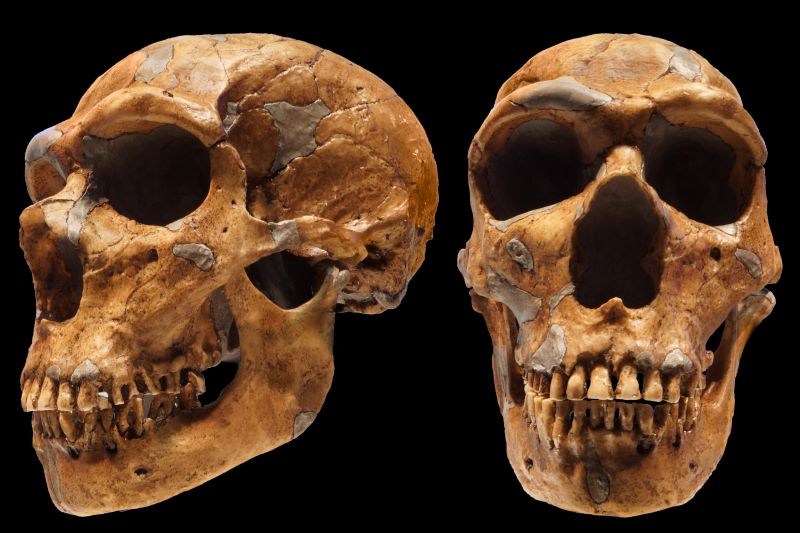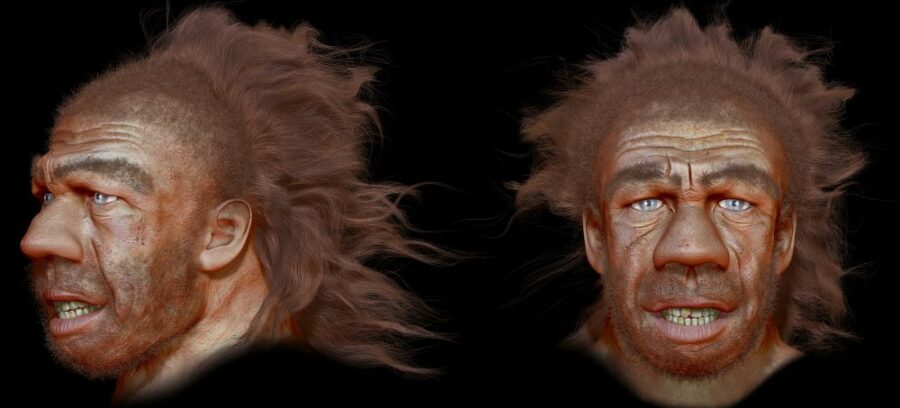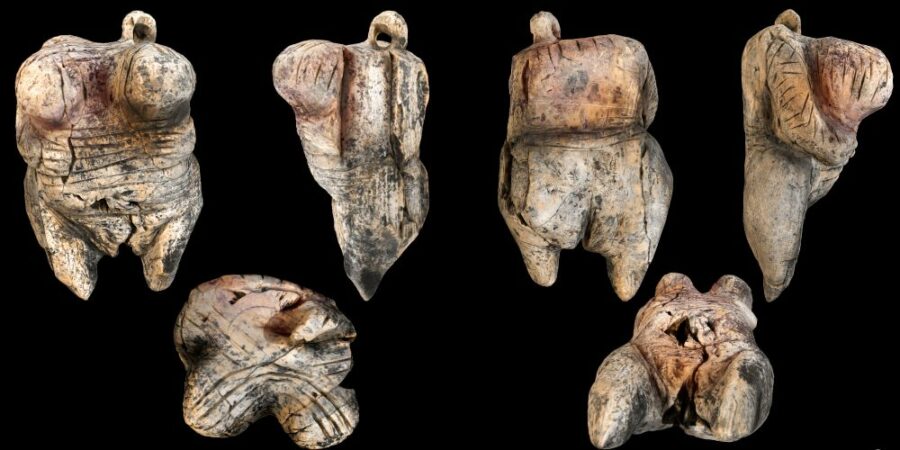The pop culture image of a prehistoric human does not match what science tells us. Our ancestors and Neanderthal cousins were by no means brutes lacking in intellect — they knew how to make jewellery and cared for their loved ones.
Contact
Andrzej Boczarowski, PhD from the Institute of Earth Sciences, University of Silesia —
andrzej.boczarowski@us.edu.pl
Neanderthal skull discovered in La Chapelle-aux-Saints | Photo: Andrzej Boczarowski
| Weronika Cygan |
Prehistoric human, a Neanderthal — usually when we hear these words, what springs to mind is an individual wearing some sort of a pelt, with dirt all over, mangled hair and a dull expression on their face. The stereotypical brute pulling his love interest by the hair into a cave has very little in common with the portrayal of ancient people offered by modern science.
A stereotype is born
Admittedly, the first palaeoanthropologists and archaeologists did not have it easy. Sometimes they were able to recover only a tooth or a few bones from the sites they investigated, but even the more complete skeletons of extinct prehumans jealously guarded their secrets from the prying eyes of the researchers. What did our prehistoric ancestors look like, who were they, and what did they do? These questions have remained in the realm of more or less accurate conjecture for decades. Modern science seems to have turned many of our beliefs completely on their head.
‘Archaeology and palaeoanthropology were born in the late 18th and early 19th centuries, and therefore were the domain of men. This means that prehistoric women were relegated to the fringes of scientific interest’, says Andrzej Boczarowski, PhD, from the Faculty of Natural Sciences of the University of Silesia. The scientist reminds us that only recently have we started to take a closer look at the role women played in our history, which was by no means inferior or less important than that of men.
Nowadays, the stereotype of the Neanderthal man with a face showing no signs of intelligence, more akin to an ape than a human, still persists. His slouched posture bears a strong resemblance to a chimpanzee holding firmly onto a club with one hand. This was the first reconstruction of the complete skeleton of our extinct cousin, found in a cave near the French village of La Chapelle-aux Saints and presented to the world by palaeontologist Marcellin Boule in 1908.
Although we now know that this caricature does not represent a real Neanderthal at all, this representation has permeated the culture and the term Neanderthal is still used as an insult for the uncultured and less clever.
Pop culture patches
Andrzej Boczarowski, PhD, lists three films that depict prehistoric women (not just Neanderthal women) in various ways, but each of them is damaging and far from the truth. The 1923 comedy Three Ages presents a frail woman with excessive make-up (!), dressed in badly stitched animal hides, who lets a man drag her around by the hair. This deliberate over-exaggeration permeated the public consciousness and was further perpetuated in later years.
One Million Years B.C. (1966) went a step further by casting Raquel Welch, a sex symbol of the time, in the role of a prehistoric woman. The eroticisation of our female ancestor, who was reduced to an object of man’s sexual desire, is evident.
Conversely, the 2004 film with a telling title of RRRRRRRRR!!! shows a strong but dim-witted giantess, who beats on everyone around her. In contrast, she was assigned a rather unassuming man as her partner. Thus, a caricature was created.
Someone could rightly point out that these productions are just comedies and no one should treat them as sources of reliable knowledge about the past. And while it is true, we do it anyway, although not entirely consciously. After all, constantly reproduced pop-cultural sources of stereotypes eventually seep into our consciousness, distancing us from the real image of our ancestors.
The image of prehistoric women
Thanks to the development of science and modern technology, we are now uncovering an increasingly large amount of secrets kept hidden by our ancestors. We can already create their portraits and attempt to reconstruct their way of life. It usually turns out that the contemporary images of ancient people are significantly different from those conceived of in the not-sodistant past, stretching back no more than a few decades.
It is well known that Homo sapiens came to Europe from Africa some 40,000–45,000 years ago. Presumably, they had black or brown hair and were darkskinned up until 6,000 BC. This is when we started to adopt a Neolithic diet, which was poorer in certain substances than the hunter-gatherer one.
‘Until then, people ate a lot of meat and fish, which contains vitamin D, so the body had no need to lighten the skin. In the Neolithic, we started growing crops and raising animals, so we didn’t eat as much game anymore’, explains Andrzej Boczarowski, PhD.
As a result of genetic mutation, blue eyes quickly became widespread among Homo sapiens, and as this trait has no practical justification, it must have been valued for its sexual attractiveness. The skeletons and bones of ancient European women preserved to this day testify to the fact that they must have had a much more delicate physique than males, but at the same time they were quite muscular (they did not, however, resemble the famous Paleolithic Venus). Aside from caring for children, they shared many responsibilities with their partners and participated in hunting activities.
The same was true for our Neanderthal relatives, as indicated by the preserved skeletons. We find the same number of injuries among Neanderthal women as we do among men. They probably occurred during encounters with wild animals, which means that women must have taken part in hunting as well.
Facial reconstruction of a Neanderthal whose skull canbe seen in the previous photograph, done by Andrzej Boczarowski, PhD | Photo: Andrzej Boczarowski
Caregivers and warriors
Today, the arsenal of tools at the disposal of an archaeologist trying to understand prehistoric humans has expanded to include some that were beyond the capabilities of science just a few decades ago. Understanding the fate of our ancestors is made possible through genetics, paleobotany, chemistry, and many other disciplines. State-of-the-art. research methods, which include isotopic dating of samples and advanced equipment significantly reducing the invasiveness of research underpin scientist’s work. For example, scanning certain remains with a CT scanner prevents them from having to compromise the often delicate structure of an object when attempting to obtain valuable information about it.
Tartar found in deceased individuals allows a glimpse into their diet, whereas marks on the bones provide evidence of past traumas and diseases. The characteristic abrasions on the incisors of Neanderthal females lead researchers to believe that they may have used their teeth when making clothes.
‘They would put a piece of animal skin in their mouths, stretch it with one hand and tan it with the other. Back then, the production of clothes must have been arduous and physically demanding’, explains the palaeontologist.
A number of findings lead us to believe that prehistoric humans extended loving care to sick and elderly members of the group. Again, the remains of a Neanderthal man from 45,000 years ago discovered in the Shanidar cave in Iraq serve as the evidence.
‘The old man whose remains were found there underwent successful medical treatment. He suffered from a withered arm, was most likely blind, and could not hear in one ear. He certainly could not walk. Despite this, he was in excellent biological condition and was buried with a great deal of care’, says Andrzej Boczarowski, PhD.
Paleolithic Venus of Hohle Fels figurine | Photo: Andrzej Boczarowski
Prehistoric beauties
The aforementioned ‘Venus’ figurines have long perplexed archaeologists. They have been found at a variety of sites constituting the remains of the oldest Homo sapiens habitats in Europe. Some of the most famous sculptures come from the Austrian town of Willendorf or the German Hohle Fels. They all have strongly emphasised female sexual features — prominent breasts, buttocks, and genitalia. Meanwhile, the arms, legs, and often the head are either disproportionately small in relation to the rest of the body or even nearly completely absent. We know that women of that time did not look like that at all. Genetic studies of Palaeolithic people clearly show that they did not starve. They were well nourished, but not obese. The ‘Venus’ figurines were most likely mere ornaments expressing certain dreams and ideas of those living at the time.
We are familiar with burials of people, both men and women, decorated with intricate jewellery. The rings, bracelets made from mammoth bones, earrings made from bear teeth, and necklaces made from rows of shells found in many graves are a testimony to the extraordinary aesthetic sense and craftsmanship of our ancestors.
There is also much circumstantial evidence to suggest that they were quite attentive to hygiene. We do not find fungal diseases around their fingers, nor traces of tooth decay, despite their teeth being heavily worn down from tanning the skins! The various delicate, incredibly sharp, and narrow tools discovered suggest that perhaps people were already shaving tens of thousands of years ago. It is certain that these tools could not have been used to cut meat.
‘Prehistoric women were therefore not dishevelled, dirty, or smelly. We have only recently discovered how dark their skin, eyes, and hair colour were; this knowledge was inaccessible to us until 10-15 years ago. Modern science not only has provided us with such information, but also shattered the previously known image of our ancestors’, says Andrzej Boczarowski, PhD.
And while today we may look back on the caricatures of ancient people introduced by researchers 50 or 100 years ago with pity, there remains the optimistic reflection that thanks to modern technology and ever-expanding knowledge, we are able to uncover more and more secrets hidden by the remains of people who died millennia ago. We can certainly look forward to lots of outstanding discoveries in the future.
The article entitled ‘Prehistoric mothers, wives and lovers’ was published in No Limits No. 1(7)/2023, the popular science journal of the University of Silesia.








